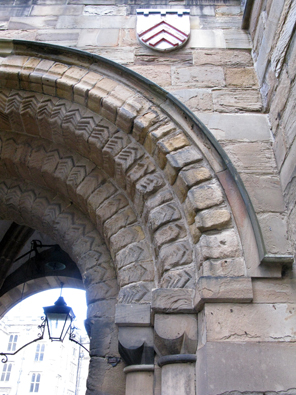
The unusually wide joints between the stones of the the gatehouse arch are the result of a 16th-century scheme to make it wider to allow the Bishop's carriage to pass through more easily.
© Jeffrey Veitch
The Castle Gatehouse evolved from a defensive structure to a ceremonial entrance.
The gatehouse arch dates from the Norman period, although its vaulted passageway is slightly later (as its gothic detailing indicates), and its upper storeys were rebuilt at the end of the 18th century.
In the sixteenth century, the original gatehouse arch was dismantled and reconstructed as a slightly wider structure, enabling the bishop's carriage to pass through more easily. This is just one indication that creating a grand residence was, at that stage, much more important than preserving the defensive role of the Castle, which had diminished. The wooden doors are thought to date from the period when the archway was widened.
The Gatehouse Moat
Until the seventeenth century, a dry moat would have preceded the gatehouse, forming an additional line of defence for the Castle. This moat was filled in under Bishop Cosin as part of extensive refurbishment aimed at making the Castle more palatial and less like a fortress. By Cosin’s time, the castle had no defensive significance and the moat was of no real value.
18th Century Alterations to the Gatehouse
The “Gothick” style alterations to the gatehouse were undertaken by the then fashionable architect James Wyatt for Bishop Barrington (1791-1826).

